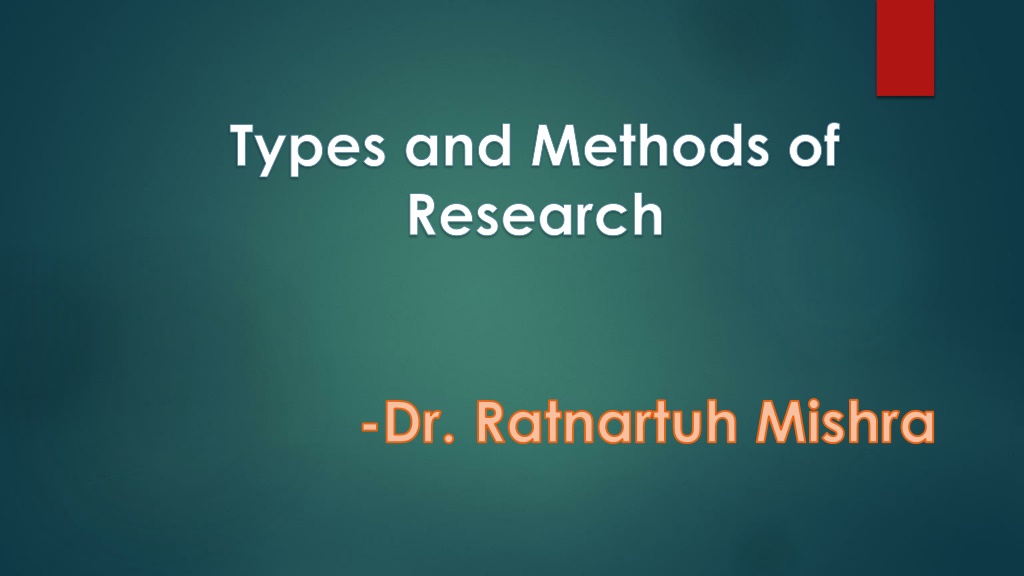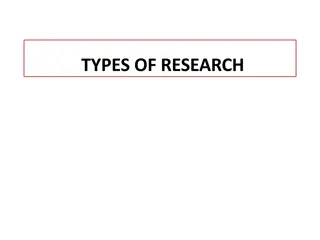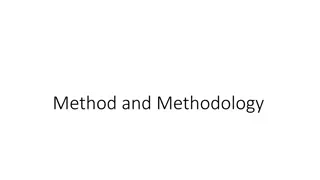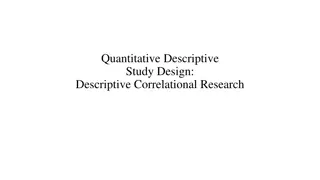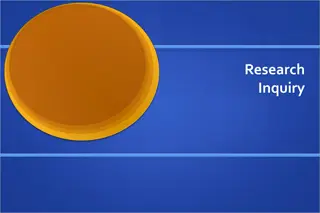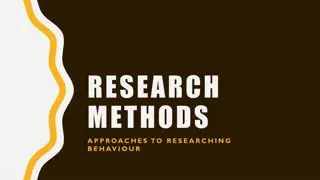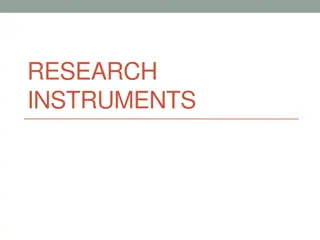Understanding Types and Methods of Research for Effective Studies
Discover the qualities of good research, characteristics of scientific study, types of research, and classifications based on objectives and approach. Learn about quantitative and qualitative research methods, including surveys, case studies, and ethnographic research.
Download Presentation

Please find below an Image/Link to download the presentation.
The content on the website is provided AS IS for your information and personal use only. It may not be sold, licensed, or shared on other websites without obtaining consent from the author. Download presentation by click this link. If you encounter any issues during the download, it is possible that the publisher has removed the file from their server.
E N D
Presentation Transcript
Types and Methods of Research -Dr. Ratnartuh Mishra
Qualities of Good Research- Solution Oriented Helpful in prediction Based on Observations and Empirical Evidences Well Planned Objective and Logical In-depth Study Verifiable Replication is possible
Characteristics of Scientific Study - Objectivity Definiteness Universality Verifiability Predictability
Scientific research is systematic , controlled, empirical and critical hypothetical proposition about the presumed relations among natural phenomena. investigation of -Fred N. Kerlinger
Classification according to Objectives of Research Fundamental Research Pure or Basic Research, to discover new knowledge, new theories, new facts, new truths. Applied Research It is the application of results of fundamental research in practical situations Action Research Emphasis is on local problem
Classification according to Research Approach Quantitative Research Qualitative Research
Quantitative Research Surveys Expost facto Studies Experimental Research
Qualitative Research Historical Research Philosophical Research Study of system or systems of thoughts Ethnographic Research Development of insight about the users that in natural environment how they interact the things Case Study Method In-depth and complete study of a case
Qualitative Research Developmental Research Study of changes over time 1. Longitudinal Study 2. Cross-sectional Study 3. Sequential Grounded Theory An inductive methodology to develop proper guidelines to gather, synthesize, analyze and conceptualize qualitative data for the construction of theory
Narrative Research This research aims to explore and conceptualize human experience as it is represented in textual forms. Exploratory Research information about the problem which is not clearly defined. It is generally qualitative but in some cases when sample for the research is large and data collection is done by the surveys and experimentation it may be quantitative. To explore the
Mixed Method Design Combination of at least one qualitative + one quantitative method Sibling of multimethod research design (a design in which either solely multiple qualitative or solely multiple quantitative approaches are used)
Steps of MM Research Analyze the situation and determine whether a mixed design is necessary Determine the rationale for the use of MM design Section of MM design Data Collection Data Analysis Data validation Data Interpretation
Types of Mixed Method Design 1. Convergent Parallel (Concurrent Triangulation) In this design we Collect the data qualitative and quantitative both at the same time Analyze the both type of data separately Compare the result of analysis of both type of data to draw overall conclusion
Embedded design- In this design one data set provides a supportive, secondary role in a study based primarily on other type of data. (Creswell, Plano Clark, et al., 2003) Example In experimental study a researcher can use qualitative data to develop a treatment or to examine the process of an intervention.
Explanatory design- It is a two phase mixed method design. The purpose of this design is that qualitative data helps explain or build upon initial quantitative results. (Creswell, Plano Clark, et al., 2003) In this design we start with the collection and analysis of quantitative data. The first phase is followed by the subsequent collection and analysis of qualitative data.
Exploratory design- It is also a two phase mixed method design. The intent of the two phase exploratory Design is that the results of the first method (qualitative) can help develop or inform second (Greene, et al., 1989) In this design we collect and analyze qualitative data first, followed by quantitative data collection and analysis. This design is generally used to explore initial questions and develop hypotheses first, then quantitative data can be used to test or confirm the qualitative findings. method (quantitative)
Classification according to Research Methods Historical Research Descriptive Research Experimental Research
Historical Research What was?
Purposes of Historical Research Reconstruction of past Discovery of unknown facts Critical investigation of relationship between the past and present To explain the significance of past behind the problems of present time
Major Differences with other types of researches are Nature of Data Methods ofAnalysis Interpretation
Sources of Historical Data Primary Sources Secondary Sources
Primary Sources Documents Oral Testimony Relics and remains Secondary Sources Text Books Biographies Book review Articles from magazines Literary criticism
Criticism of Historical Data External Criticism Originality, Trustworthiness, Genuineness, Authenticity of the document. It deals with external aspects of a document. Internal Criticism - Authenticity of the content of the document. It deals with internal aspects of a document. In internal criticism two types of errors are possible 1. Errors of Good Faith deliberate and intentional 2. Errors ofAccuracy It is due to defective source of information
